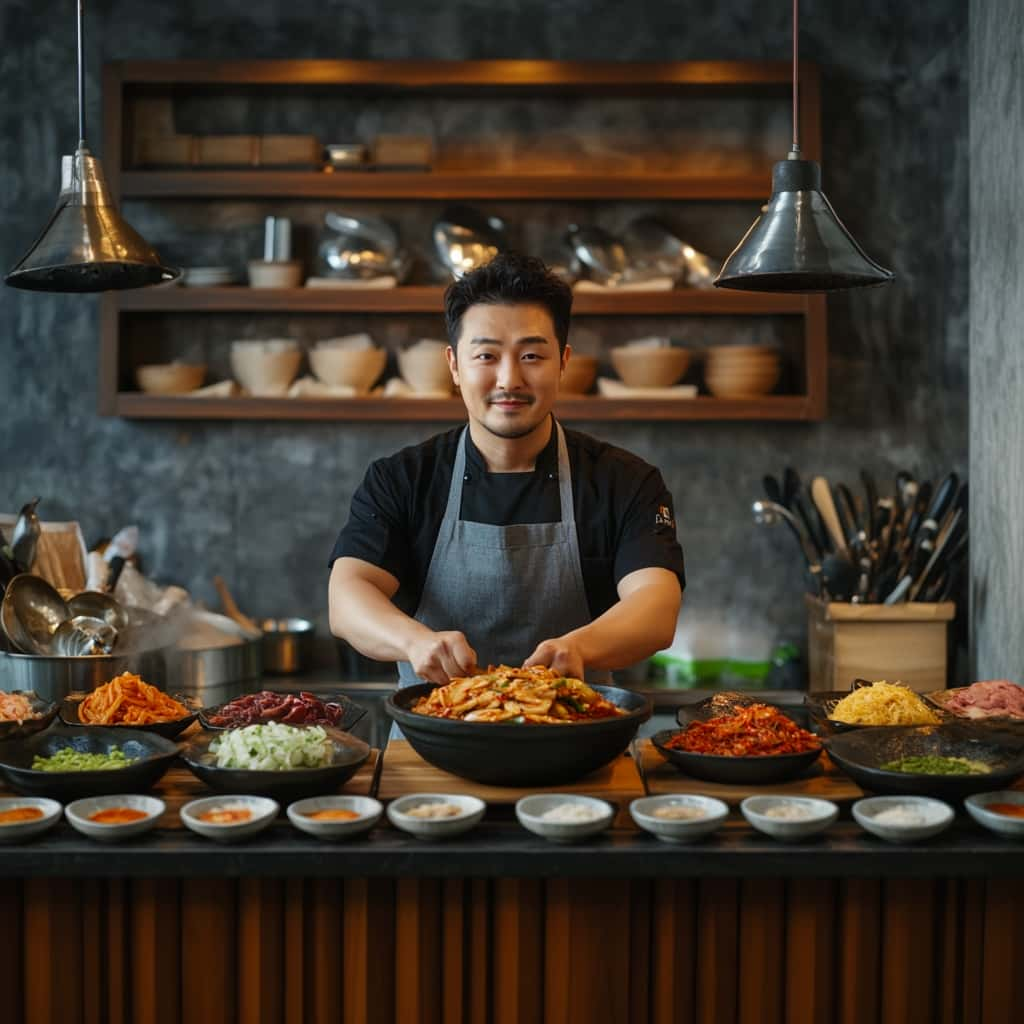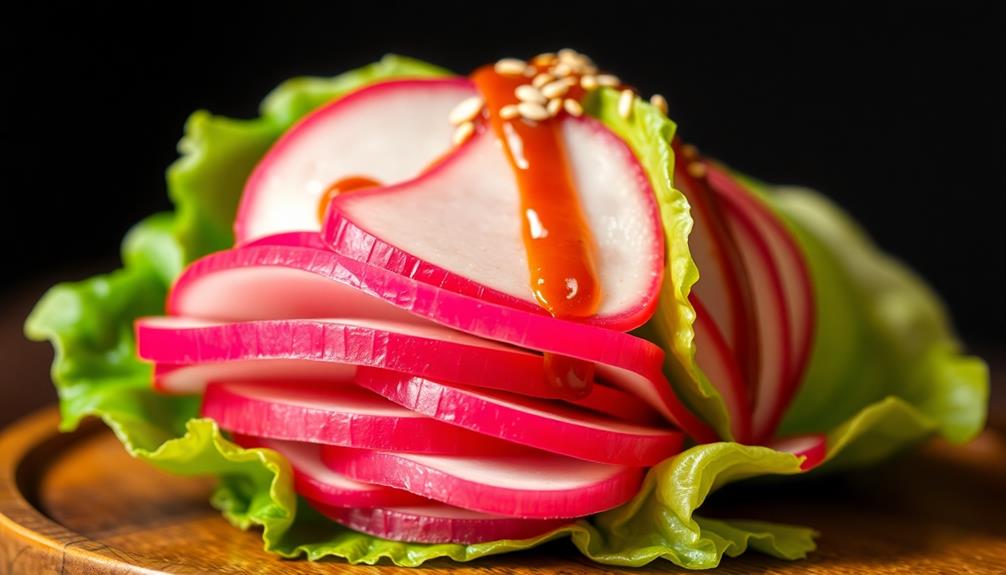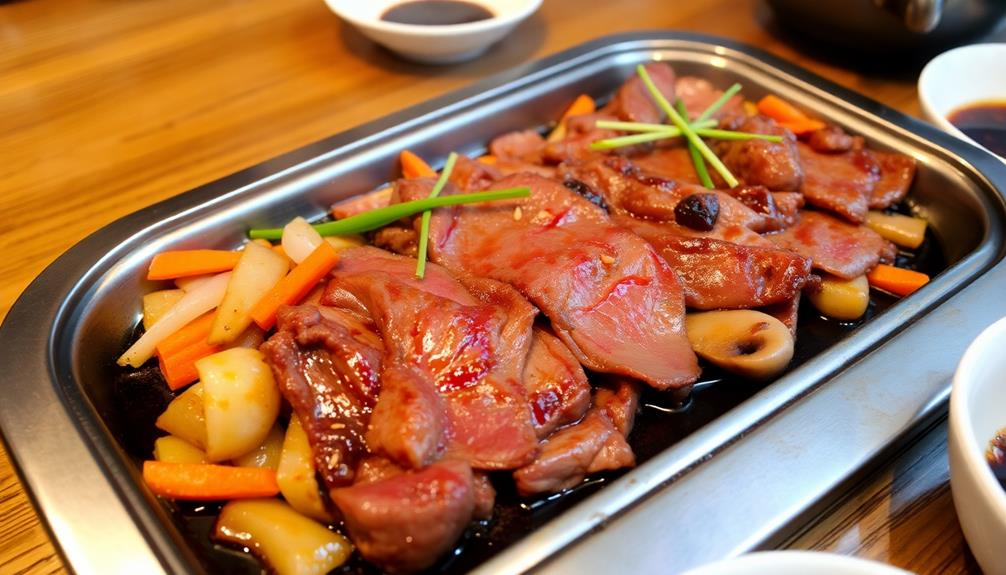Bossam, or boiled pork wraps, is a tasty Korean dish that's all about fun! You'll enjoy tender, boiled pork that's perfectly seasoned and then wrapped in crisp lettuce or cabbage leaves. It's great for sharing with friends and family during special occasions. You can customize your wrap with fresh veggies like radishes and cucumbers, plus a spicy sauce for an extra kick! Making Bossam is interactive and enjoyable, so everyone can create their own delicious masterpiece. Get ready for a delightful experience filled with flavor and laughter, and there's even more to discover about this scrumptious dish!
Key Takeaways
- Bossam is a traditional Korean dish featuring tender boiled pork wrapped in cabbage leaves, originating from the Joseon Dynasty.
- The dish symbolizes togetherness and is commonly enjoyed during special occasions like birthdays and holidays.
- Preparation involves simmering quality pork belly with spices and serving it with fresh vegetables and spicy sauces.
- Diners customize their wraps with toppings like garlic and green onions, enhancing the interactive dining experience.
- A flavorful spicy sauce made with gochujang complements the bossam wraps, adding depth and heat to the meal.
History
Bossam, a beloved Korean dish, has a rich history that dates back to the Joseon Dynasty. It's said that this delightful meal was created for royalty, showcasing the culinary skills of the time. Imagine a feast where tender boiled pork, wrapped in fresh cabbage leaves, was served with various side dishes. Doesn't that sound delicious?
As you dive into the history of bossam, you'll find that it's more than just food; it's a symbol of togetherness. Families would gather around the table, enjoying this dish during special occasions like birthdays and holidays. The warm, savory flavors brought everyone closer, creating cherished memories.
Over time, bossam evolved, with different regions adding their own twists. For example, some folks love to add spicy sauces or pickled veggies to make it even tastier. Isn't it cool how a simple dish can change and adapt while still holding onto its roots?
Recipe
Bossam, or boiled pork wraps, is a beloved Korean dish that brings together tender, flavorful pork and an array of fresh vegetables. Traditionally enjoyed during special occasions or family gatherings, this dish is a delightful combination of textures and flavors that can be customized to suit individual tastes. The key to great bossam lies in the quality of the pork and the accompanying sides, which add a refreshing contrast to the rich meat. In addition to the pork and vegetables, bossam is often served with a variety of condiments such as kimchi, pickled radishes, and ssamjang, a spicy and savory dipping sauce. Some variations of bossam may also include servings of sundae blood sausage, providing an extra depth of flavor to the meal. The combination of all these elements creates a truly satisfying and memorable dining experience.
(Note: Sundae blood sausage is a traditional Korean sausage made with a mixture of pork, glass noodles, and barley.
To make bossam, the pork is usually simmered until it's incredibly tender and infused with aromatic spices. Once the pork is ready, it's thinly sliced and served with various accompaniments like pickled vegetables, garlic, and sesame oil, all wrapped in lettuce leaves. This dish isn't only delicious but also interactive, as diners can create their own wraps, making it a fun meal for gatherings.
Ingredients:
- 2 pounds pork belly
- 1 onion, quartered
- 4 cloves garlic, crushed
- 1-inch piece ginger, sliced
- 1 tablespoon black peppercorns
- 1 tablespoon salt
- 1 tablespoon sugar
- 1 cup napa cabbage, chopped
- 1 cup radish, sliced
- 1 cup cucumber, sliced
- 1 tablespoon sesame oil
- Lettuce leaves for wrapping
- Ssamjang (Korean dipping sauce)
To prepare bossam, start by placing the pork belly in a large pot. Add the quartered onion, crushed garlic, sliced ginger, black peppercorns, salt, and sugar. Pour enough water to cover the pork completely and bring it to a boil over medium-high heat.
Once boiling, reduce the heat to low and let it simmer for about 2 to 3 hours, or until the pork is fork-tender. Once cooked, remove the pork from the pot and let it rest for a few minutes before slicing it thinly. Serve the sliced pork with the chopped napa cabbage, sliced radish, cucumber, lettuce leaves, and ssamjang for dipping.
When making bossam, it's essential to let the pork belly rest after cooking to allow the juices to redistribute, ensuring every bite is moist and flavorful. Feel free to experiment with different pickled vegetables or add some spicy kimchi for an extra kick.
Additionally, using a combination of leafy greens, such as perilla leaves or romaine lettuce, can elevate the dish, providing both flavor and variety in texture. Enjoy the interactive experience of wrapping your favorite ingredients and customizing each bite to your liking!
Cooking Steps
Get ready to make some delicious Bossam!
First, you'll prepare the pork belly slices, seasoning them with garlic and ginger to pack in flavor.
Once that's done, you'll blanch the meat in boiling water before wrapping it in crunchy lettuce leaves and adding a spicy sauce drizzle that'll make your taste buds dance!
Step 1. Prepare Pork Belly Slices
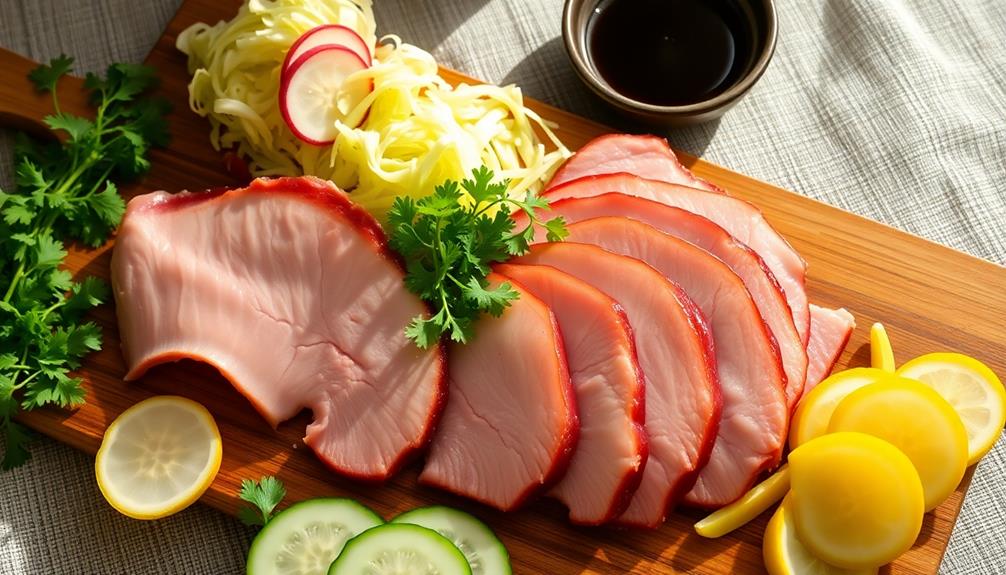
To prepare the pork belly slices for your bossam, start by selecting a high-quality cut that's well-marbled for maximum flavor and tenderness.
Once you've got your pork belly, place it on a clean cutting board. With a sharp knife, slice the pork belly into thick pieces, about one inch wide. This size is perfect for cooking and wrapping later on.
Next, gather your ingredients! You'll want to have a pot of water ready to boil. If you're feeling adventurous, toss in some aromatics like green onions or a piece of ginger for a little extra zing.
Carefully drop the pork belly slices into the boiling water. Make sure they're submerged, so they cook evenly. Let them simmer for about 30 to 40 minutes. You can check the meat's tenderness with a fork—it should be easy to pierce.
While the pork belly cooks, you might want to dance around the kitchen a bit! It'll be worth the wait.
Once the time's up, remove the slices and let them cool slightly. You're now ready for the next delicious steps in making bossam! Enjoy the aroma; it's heavenly!
Step 2. Season With Garlic and Ginger

After the pork belly has simmered and cooled slightly, it's time to infuse it with the bold flavors of garlic and ginger. First, grab a few cloves of fresh garlic and a piece of ginger. You'll want about four cloves of garlic and a one-inch chunk of ginger. Peel them both, then chop them into tiny pieces. The smaller they are, the better they'll mix with the pork!
Additionally, consider creating a stimulating atmosphere in your kitchen by diffusing essential oils like rosemary or peppermint, which can enhance your focus and mood while you cook. Essential oils for mental clarity.
Now, take your cooled pork belly and place it in a large bowl. Sprinkle the minced garlic and ginger all over the meat, making sure to cover it evenly. You can use your hands to rub the flavors into the pork, which is way more fun than it sounds!
Don't forget to wash your hands afterward, though!
Next, add a pinch of salt, which helps bring out the flavors of the garlic and ginger. Toss everything together gently, and let it sit for about fifteen minutes. This resting time allows the pork to soak up all those delicious flavors, making each bite a tasty explosion.
You're almost ready to turn this into an amazing bossam feast, so stay tuned for the next step!
Step 3. Blanch in Boiling Water
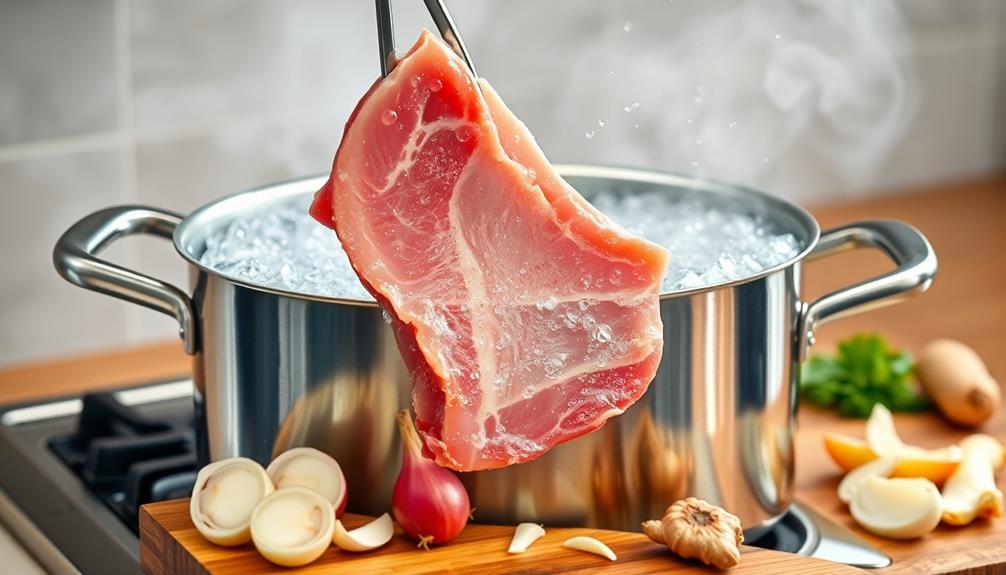
Now that the pork belly has absorbed the flavors of garlic and ginger, it's time to blanch it in boiling water to achieve that perfect texture.
First, fill a large pot with water and bring it to a rolling boil. While you're waiting for the water to heat up, grab the marinated pork belly and cut it into manageable pieces—about two to three inches wide.
Once the water is bubbling, carefully place the pork pieces into the pot. Be cautious; the steam might be a little intense! You'll want to let the pork cook for about five minutes. This blanching step helps seal in the juicy flavors while also removing any impurities.
After the time's up, use tongs to take out the pork and place it in a bowl. Let it cool for a moment, so you don't burn your fingers.
If you want to add a little extra flavor, you can save the boiling water to simmer some veggies or make a broth later!
Now, you're ready to move on to the next exciting step in making your delicious Bossam wraps. Happy cooking!
Step 4. Wrap in Lettuce Leaves
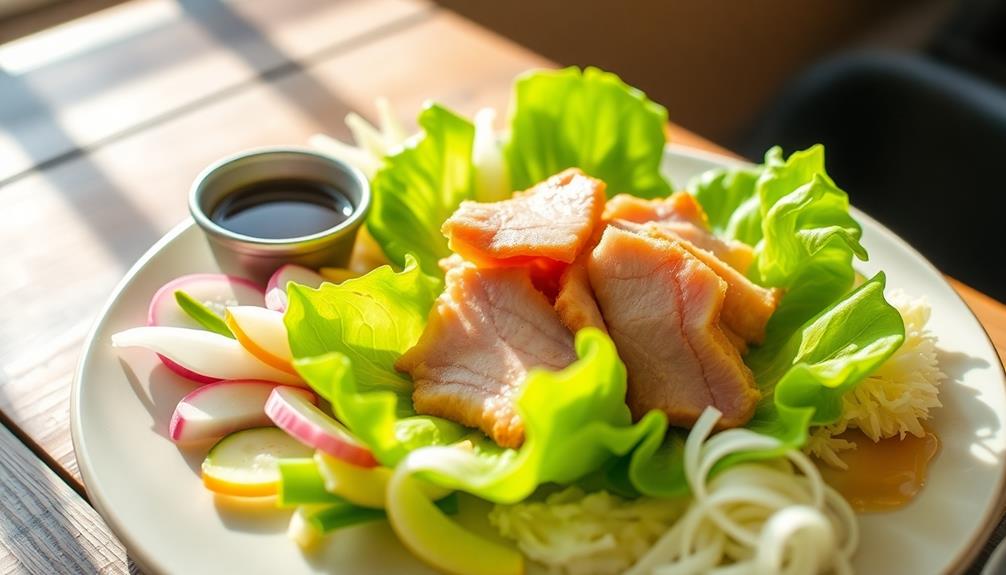
As you prepare to wrap your delicious pork belly, gather some fresh lettuce leaves—these will serve as the perfect vessel for all those savory flavors. Choose large, sturdy leaves, like romaine or butter lettuce, so they can hold everything together without tearing.
Now, take a piece of pork belly and place it in the center of a lettuce leaf.
Next, you'll want to add some toppings, like sliced garlic, green onions, or even a sprinkle of sesame seeds if you like! This step is where you can get creative, adding whatever extra crunch or flavor you enjoy.
Once you've got your fillings just right, it's time to wrap it up! Fold the sides of the lettuce over the pork, then roll it up from the bottom to the top, creating a neat little package.
Don't worry if it's not perfect; every wrap is unique, just like you!
Now, hold your wrap in one hand and get ready to take a big bite. You'll love how the tender pork and fresh lettuce come together, making each mouthful a delightful experience. Enjoy your tasty creation!
Step 5. Add Spicy Sauce Drizzle
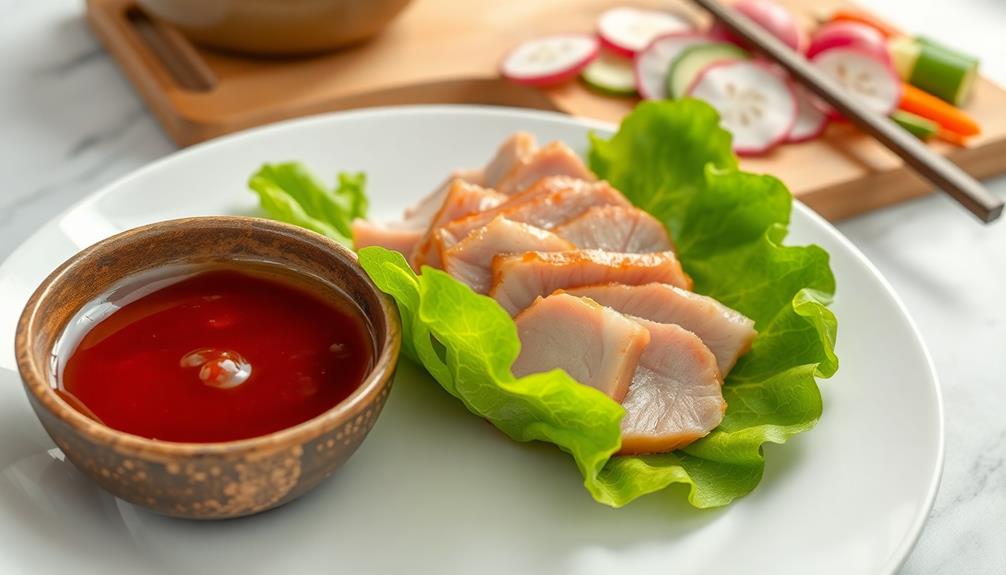
Often, a spicy sauce drizzle elevates your bossam wraps, adding a kick that perfectly complements the rich flavors of the pork. To create this zesty sauce, you'll need some gochujang, which is a Korean chili paste, soy sauce, a splash of rice vinegar, and a dash of sesame oil.
Start by grabbing a small bowl, then mix together two tablespoons of gochujang with one tablespoon of soy sauce. Next, add a teaspoon of rice vinegar to give it that tangy zing. Finally, drizzle in just half a teaspoon of sesame oil for a nutty finish.
Now, stir everything together until it's nice and smooth. You can taste it and adjust the flavors if you want more heat or tang. Once it's perfectly suited to your taste buds, it's time to drizzle!
Take your bossam wraps, already filled with tender pork and fresh veggies, and lightly drizzle the spicy sauce over the top. If you're feeling adventurous, you can even dip your wraps into the sauce for an extra kick!
Enjoy each bite as the flavors dance together, creating a delicious party in your mouth. Happy eating!
Final Thoughts
When it comes to enjoying bossam, the experience is just as important as the dish itself. Picture this: you're gathered around a table with your family or friends, everyone excitedly chatting and laughing while savoring those delicious boiled pork wraps. You can almost taste the fun in the air!
Bossam isn't just a meal; it's a celebration of flavors and togetherness.
As you wrap the tender pork in fresh lettuce, don't forget to add some spicy sauce and side dishes like garlic or pickled radish. Each bite is a delightful mix of flavors that dance in your mouth!
Take your time, enjoy the textures, and share stories with your loved ones. It's all about creating memories while relishing the food.
Frequently Asked Questions
What Type of Meat Is Best for Making Bossam?
When you're choosing meat for a dish, look for cuts that are tender and flavorful. Pork belly or shoulder works great, as they're juicy and absorb seasonings well, enhancing the overall taste of your meal.
Can I Use Lettuce Instead of Cabbage for Wraps?
You can definitely use lettuce instead of cabbage for wraps! It adds a fresh crunch and makes it lighter. Just be sure to choose sturdy lettuce like romaine or butter for better support. Enjoy experimenting!
How Long Can Leftover Bossam Be Stored?
You can store leftovers in the refrigerator for up to three to four days. Make sure to keep them in an airtight container. If you want to extend their life, consider freezing them for later use.
What Sides Pair Well With Bossam?
When you're enjoying a flavorful meal, consider pairing it with kimchi, pickled radishes, or fresh lettuce. These sides enhance the main dish's taste, bringing out its rich flavors and adding a refreshing crunch.
Is Bossam Suitable for Gluten-Free Diets?
Yes, bossam can be suitable for gluten-free diets. Just ensure you use gluten-free sauces or wraps. Always check ingredient labels carefully, and you'll enjoy a delicious meal without worrying about gluten. Enjoy your dining experience!


